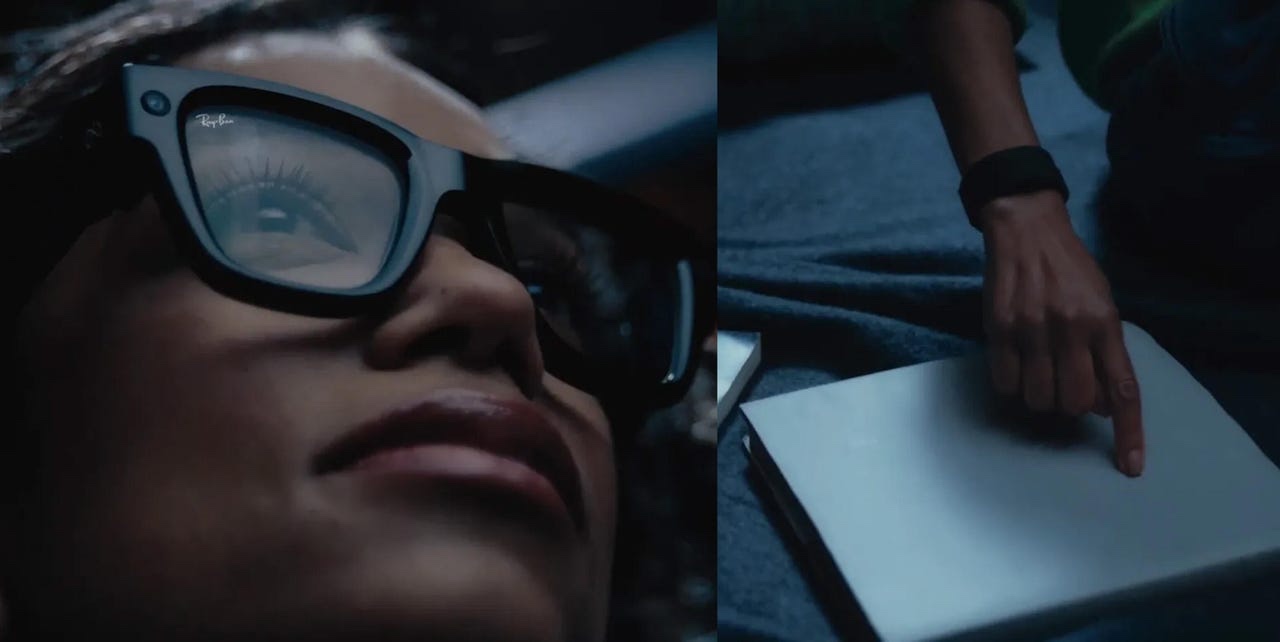
Meta just pulled smart glasses into the mainstream. At Connect 2025, the company unveiled Meta Ray-Ban Display — classic Wayfarers with a private, full-color screen inside the right lens and a wrist-worn Neural Band for subtle gesture control. It’s not full AR, but a fast, glanceable HUD for messages, navigation, calls, captions, and Meta AI — designed to be there when you need it and gone when you don’t.

Full specifications
• Display: 600 × 600 pixels, 20-degree FOV, 42 PPD, 30–5,000 nits peak, 90 Hz panel (content at 30 Hz), less than 2% light leakage for privacy
• Placement: Off-to-the-side monocular HUD in the right lens; optimized for short, controlled interactions without blocking your view
• Camera: 12 MP with viewfinder in the lens, 3× digital zoom; photos up to 3024 × 4032; video up to 1080p/30
• Audio: Dual open-ear speakers, five microphones, capture LED for privacy
• Weight & sizes: 69 g glasses; two frame sizes (standard and large)
• Battery: Up to 6 hours mixed use; collapsible charging case takes total up to 30 hours; 50% charge in ~20 minutes in case
• Lenses & prescriptions: Transitions lenses by default; prescriptions supported (range shared during briefings up to −4.00 to +4.00)
• Colors: Black, Sand
• Chipset: Qualcomm Snapdragon AR1 Gen 1 (same platform as Ray-Ban Meta lineup)

Neural Band: how the EMG wristband changes everything
Meta’s Neural Band reads tiny electrical signals from your wrist muscles (EMG) and turns them into commands, so you can swipe, pinch, click, and even dial volume with a pinch-and-twist — without touching your face or pulling out your phone. It’s built for all-day comfort with up to 18 hours of battery life and IPX7 water resistance, and the strap uses Vectran fiber (the Mars rover crash-pad material) for strength and flexibility. In practice, the band unlocks truly silent, precise control for messaging, music, maps, and Meta AI.

What it’s like to use
In early demos, the 5,000-nit display stayed readable outdoors against bright sky and pavement, and the off-axis placement makes it feel like a quick glance rather than a screen glued to your gaze. Live captions and on-device translation pop in as needed, turn-by-turn walking directions render as a mini-map, and the lens-level viewfinder finally makes framing POV photos feel natural.

Price and availability
• Price: $799, including Meta Neural Band
• On sale: September 30, 2025, US only at launch (in-person fitting required)
• Retailers (US): Best Buy, LensCrafters, Sunglass Hut, Ray-Ban Stores; select Verizon stores to follow
• Global rollout: Early 2026 in Canada, France, Italy, and the UK; more options over time

Why it matters
This is Meta’s first Ray-Ban with a real in-lens screen — not just camera glasses. The combo of a private HUD and EMG control solves the “how do I interact without looking awkward?” problem better than any consumer glasses to date. It’s a deliberate step between camera wearables and full AR, aimed at making everyday tasks faster without hijacking your vision.

Cons
• Monocular display limits immersion versus true AR headsets
• Six-hour battery can feel short for heavy use days
• Learning curve for EMG gestures, fit and sizing matter for accuracy
• US-only at launch, global buyers wait until 2026

How it stacks up
• Ray-Ban Meta Gen 2 (no display): Cheaper and lighter with 8-hour battery and upgraded capture, but no HUD. Display wins on navigation, captions, and glanceable AI.
• Apple Vision Pro: Far more immersive, but huge, expensive, and not street-wearable. Ray-Ban Display trades immersion for everyday discretion and comfort.

What others say
“The $799 Meta Ray-Ban Display glasses add a wide range of new features, like live captioning and a neural wristband.” — The Verge
“Meta unveiled AI-powered smart glasses with a built-in display and a neural wristband, on sale September 30 for $799.” — AP News

FAQ
• What’s the exact screen resolution and field of view?
600 × 600 pixels at a 20-degree FOV, 42 PPD; up to 5,000 nits peak.
• Is this full AR?
No. It’s a monocular HUD off to the side for quick, private interactions, not holograms anchored in your world.
• How long does the battery last?
Up to 6 hours on the glasses; up to 30 hours total with the collapsible case.
• Can I get prescriptions?
Yes, prescriptions are supported; Meta highlighted Transitions lenses at launch.

Editor’s take
Meta Ray-Ban Display is the most convincing bridge to everyday AR we’ve tried: a bright, private HUD plus wrist-level control that finally feels natural. It won’t replace a true AR headset, but it nails the “seconds-long” tasks you do a hundred times a day.
Score: 4.6/5







